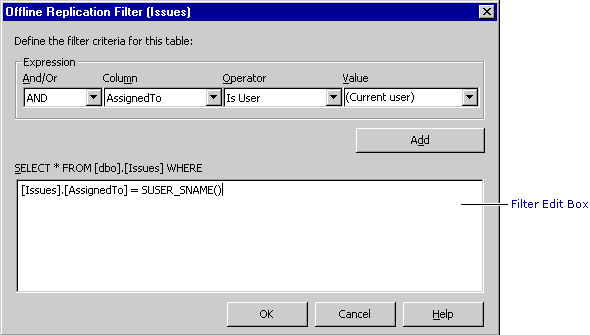
Offline publication filtering provides a mechanism for limiting the information contained in a publication. When creating your offline publications, you can use filters to make specialized publications by specifying a simple expression.
For more information about creating offline publications, see Allowing Users to Work Offline.
The Microsoft Access Workflow Designer for Microsoft SQL Serverô helps you create these filter expressions through a simple interface where you identify a column from the table, an operator, and a value by which to filter. When you click Add, the Access Workflow Designer creates the T-SQL expression and inserts it at the current insertion point. If the current insertion point is at the beginning of the text field, no AND/OR keyword is produced.
You also can edit the expression in the text field directly. When you click OK, the Access Workflow Designer validates the SQL text. If the SQL text is not valid, a message appears warning you of problems.

The operators available depend on the data type of the selected columns, and the values available depend on the operator selected. Some operators have predefined values, but the Values field is a combo box that makes it possible for users to either select from the list or type in their own values.
| Operators available | Values | SQL statement |
| Equals |
|
|
| Is Not Equal to |
|
|
| Is Like |
|
|
| Is Not Like |
|
|
| Is User | "Current user," account names from the modUserList view |
|
| Is Not User | "Current user," account names from the modUserList view |
|
| Is Null |
|
|
| Is Not Null |
|
| Operators available | SQL statement |
| Is Like |
|
| Is Not Like |
|
| Is Null |
|
| Is Not Null |
|
| Operators available | SQL statement |
| Less Than |
|
| Less Than or Equal to |
|
| Greater Than |
|
| Greater Than or Equal to |
|
| Equals |
|
| Not Equal to |
|
| Is Null |
|
| Is Not Null |
|
| Operators available | Values | SQL statement |
| Less Than | List of lookup keywords |
|
| Less Than or Equal to | List of lookup keywords |
|
| Greater Than | List of lookup keywords |
|
| Greater Than or Equal to | List of lookup keywords |
|
| Equals | List of lookup keywords |
|
| Not Equal to | List of lookup keywords |
|
| Is Null |
|
|
| Is Not Null |
|
| Operators available | Values | SQL statement |
| Equals | "Today", "1 day ago", "1 day from now", (repeat for 2-6 days), "1 week ago", "1 week from now", (repeat for 2-4 weeks), "1 month ago", "1 month from now", (repeat for 2,4,6 months), "1 year from now", "1 year ago" |
|
| Not Equal to | "Today", "1 day ago", "1 day from now", (repeat for 2-6 days), "1 week ago", "1 week from now", (repeat for 2-4 weeks), "1 month ago", "1 month from now", (repeat for 2,4,6 months), "1 year from now", "1 year ago", |
|
| Before | "Today", "1 day ago", "1 day from now", (repeat for 2-6 days), "1 week ago", "1 week from now", (repeat for 2-4 weeks), "1 month ago", "1 month from now", (repeat for 2,4,6 months), "1 year from now", "1 year ago" |
|
| Before or Equal to | "Today", "1 day ago", "1 day from now", (repeat for 2-6 days), "1 week ago", "1 week from now", (repeat for 2-4 weeks), "1 month ago", "1 month from now", (repeat for 2,4,6 months), "1 year from now", "1 year ago" |
|
| After | "Today", "1 day ago", "1 day from now", (repeat for 2-6 days), "1 week ago", "1 week from now", (repeat for 2-4 weeks), "1 month ago", "1 month from now", (repeat for 2,4,6 months), "1 year from now", "1 year ago" |
|
| After or Equal to | "Today", "1 day ago", "1 day from now", (repeat for 2-6 days), "1 week ago", "1 week from now", (repeat for 2-4 weeks), "1 month ago", "1 month from now", (repeat for 2,4,6 months), "1 year from now", "1 year ago" |
|
| Is Null |
|
|
| Is Not Null |
|
| Operators available | Values | SQL statement |
| Equals | "True", "False" |
|
| Not Equal | "True", "False" |
|
| Is Null |
|
|
| Is Not Null |
|
Note The lookup keywords should be listed as "value - keyword," where value is the integer value stored in the table.